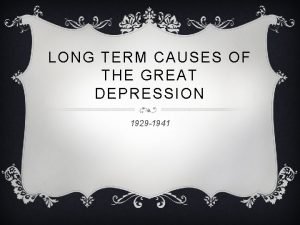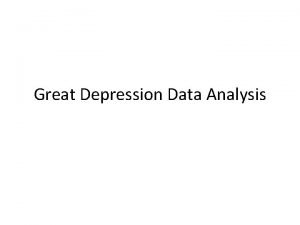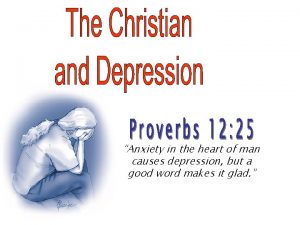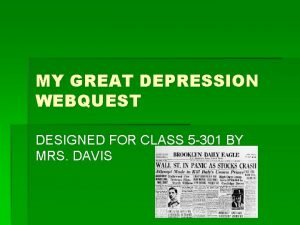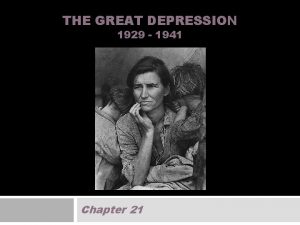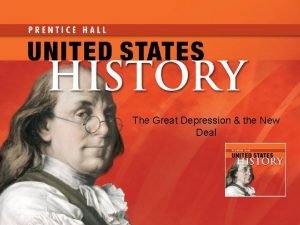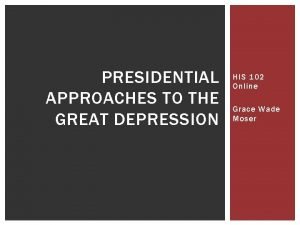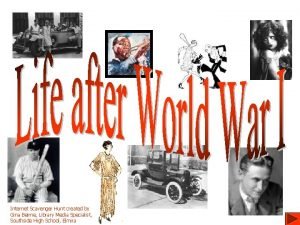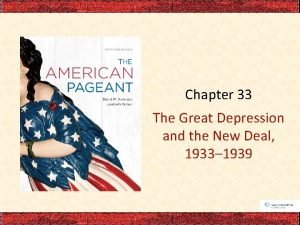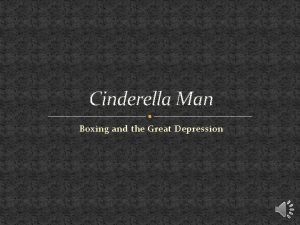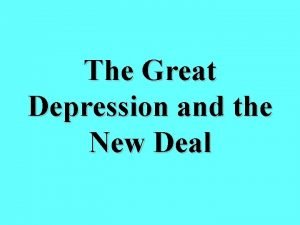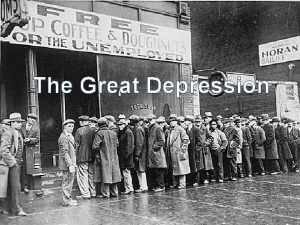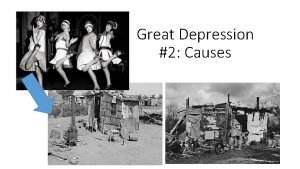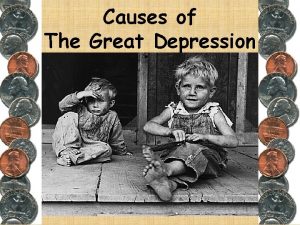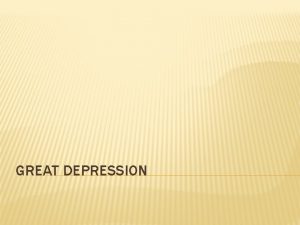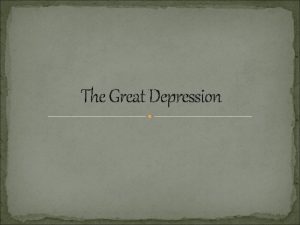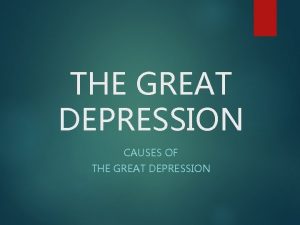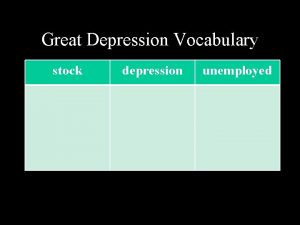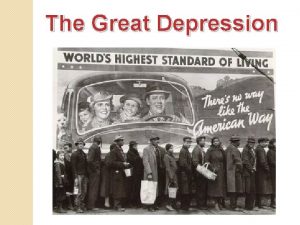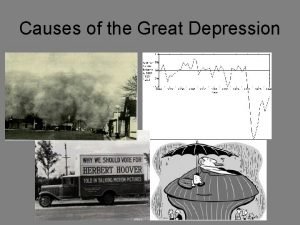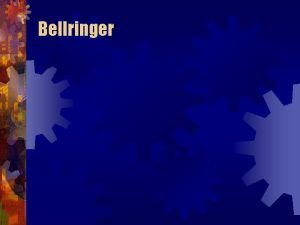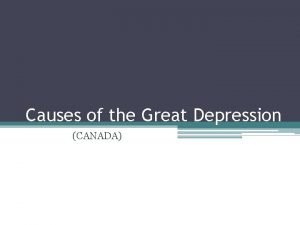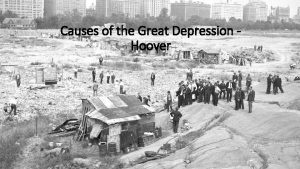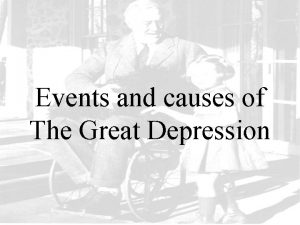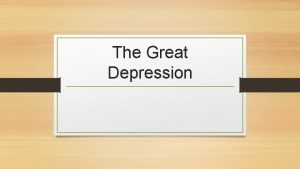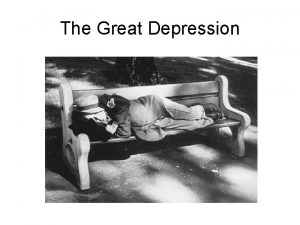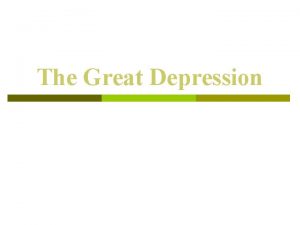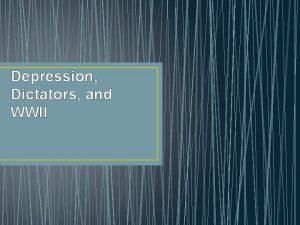THE GREAT DEPRESSION CAUSES OF THE GREAT DEPRESSION
























- Slides: 24

THE GREAT DEPRESSION

CAUSES OF THE GREAT DEPRESSION • The 1920’s were a decade of consumer spending & the economy looked healthy on the surface • Income did increase but there were some severe problems with the economy • October 1929: The “Roaring 20’s” came to an end and the Great Depression began……. .

WEAK INDUSTRIES & OVERPRODUCTION • Mass-production of consumer goods led to overproduction (because of WWI) • People did not need as many consumer goods and began buying less (under consumption) • Railroads, textiles, steel, coal mining, and construction were barely profitable • Demand for agricultural products declines • Too much food leads to a drop in crop prices • Farmers can’t afford to pay back loans and their farms foreclosed


CREDIT • Many Americans used easy credit to live beyond their means • They generated large debts • Companies could not collect the money from the items they sold on credit • Americans cut back on spending

UNEVEN DIVISION OF WEALTH • Despite rising wages, the gap between the rich & poor grew wider in the 1920’s • 70% of Americans were considered “poor” • Most of the spending was done by 30% of the population


THE STOCK MARKET • In the 1920’s the stock market soared and people speculated with stocks • Many people borrowed money to pay for stocks, called buying on margin • There was no regulation of the market & some companies altered stock values to raise profits • October 29 th, 1929 (Black Tuesday) the stock market crashed • Black Tuesday – You. Tube video



THE STOCK MARKET CONT. • People rushed to banks, prices plummeted, and investors lost $30 billion • Speculators who bought on the margin could not pay off their debts • Many lost their savings


BANK FAILURES • After the crash, people tried to withdraw their money from banks – “Run on the Banks” • 600 banks failed due to lack of funds and the inability to recoup loans • The failure of the banks left many Americans without their life savings


FOREIGN TRADE • Post-War debts in Europe and high protective tariffs in the US limited international trade • The Great Depression led to a global depression in Europe, Asia, & Latin America • World trade fell by 40%

CONSUMER CONFIDENCE • Millions of Americans lost their jobs or took pay cuts to keep their jobs • The lack of confidence in the future kept people from spending money • The lack of spending made the depression drag on until the 1940’s

EFFECTS OF THE GREAT DEPRESSION • Led to a collapse of the US financial system • 25, 000 banks and 90, 000 businesses failed by 1933 • Unemployment peaked at 25% • Many Americans lost their homes • America had record poverty & suicide rates; fathers abandoned families; healthcare declined (many children died of malnutrition) • Private charities created soup kitchens and breadlines to help


THE DUST BOWL • The effects of the Great Depression were made worse by the Dust Bowl: • Heavy droughts & over farming in the West destroyed the Plains • In the early 1930’s, windstorms swept away loose soil • Farmers in the Plains left their farms & searched for work or better land in the West coast states


PRESIDENT HOOVER’S RESPONSE TO THE GREAT DEPRESSION • President Hoover initially rejected bold gov’t action • He tried to reassure Americans that prosperity would return • He called for volunteerism & “rugged individualism” – Americans need to work • He eventually called for more gov’t action: • Relief checks to help the unemployed • The Reconstruction Finance Corps (RFC) loaned money to businesses • Created building projects like Hoover Dam • These efforts did not end the depression and many citizens lost faith in Hoover • Americans who lost their homes lived in shantytowns nicknamed “Hoovervilles”


HOOVERVILLES • Hoovervilles – You. Tube video

SOME LONG-TERM EFFECTS • Many Americans became more thrifty (saving things instead of throwing away). • Many started savings accounts for the first time. • Many stopped putting so much on credit. • Many became leery of the Stock Market.
 What were the long term causes of the great depression
What were the long term causes of the great depression Great depression causes
Great depression causes Great depression vocabulary jeopardy
Great depression vocabulary jeopardy Anxiety in the heart of man causes depression
Anxiety in the heart of man causes depression Proximate behaviour in animals
Proximate behaviour in animals Proximate vs ultimate causation
Proximate vs ultimate causation Great depression webquest
Great depression webquest Great depression vocabulary jeopardy
Great depression vocabulary jeopardy Hoovervilles great depression
Hoovervilles great depression Http://www.history.com/topics/great-depression
Http://www.history.com/topics/great-depression Great depression jeopardy
Great depression jeopardy Great depression vocab
Great depression vocab The ingenious quarterback political cartoon
The ingenious quarterback political cartoon Hoover's poor farm tobacco fund
Hoover's poor farm tobacco fund Five effects of the great depression
Five effects of the great depression Great depression photographer
Great depression photographer Great depression
Great depression Hoovervilles great depression
Hoovervilles great depression How did the great depression impact the world
How did the great depression impact the world Module 9 lesson 2
Module 9 lesson 2 Chapter 33 the great depression and the new deal
Chapter 33 the great depression and the new deal Boxing during the great depression
Boxing during the great depression Hawley smoot tariff apush
Hawley smoot tariff apush What is deflation
What is deflation Great depression
Great depression
